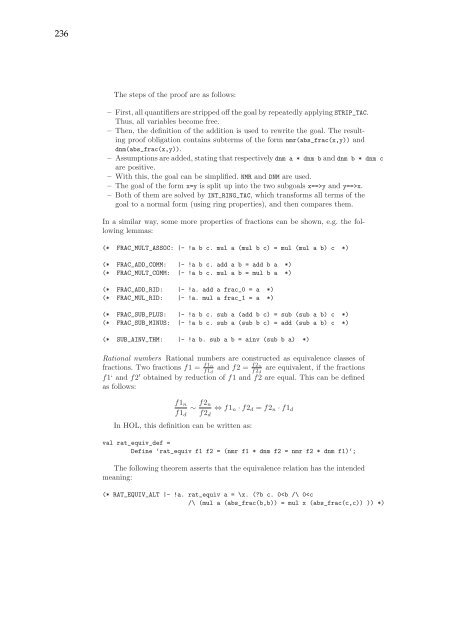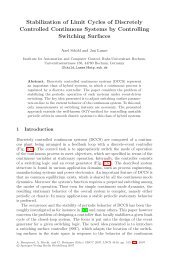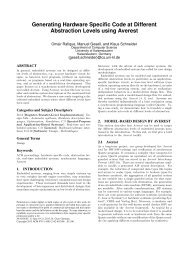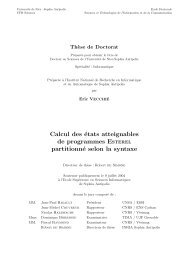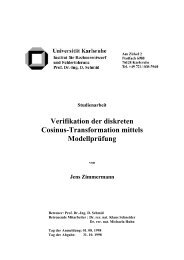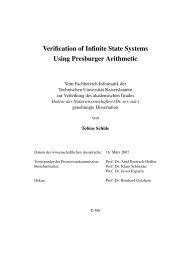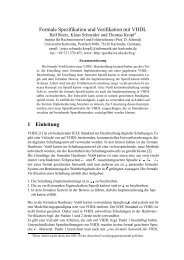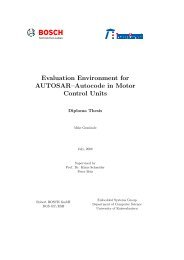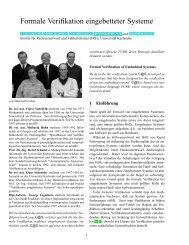- Seite 1:
Verifikation reaktiver Systeme Semi
- Seite 5:
Inhaltsverzeichnis Grundlagen des
- Seite 8 und 9:
2 Der Aufbau der Arbeit ist in fün
- Seite 10 und 11:
4 2.3 SAT Unter SAT versteht man da
- Seite 12 und 13:
6 Eigenschaft spezifiziert sein sol
- Seite 14 und 15:
8 3.3 LTL spezifisch: Semantische G
- Seite 16 und 17:
10 3.5 LTL spezifisch: Änderung de
- Seite 18 und 19:
12 von der Position aus der die Sch
- Seite 20 und 21:
14 4 Industrieller Einsatz Die Halb
- Seite 22 und 23:
16 Betrachtet man nun die Schaltung
- Seite 24 und 25:
18 Diese einzelne Eigenschaft allei
- Seite 26 und 27:
20 5 Auseinandersetzung Nachdem nun
- Seite 28 und 29:
22 zu finden. Weitere Vorteile von
- Seite 30 und 31:
24 A 2-Bit Zähler Anhand des Zähl
- Seite 32 und 33:
26 B Temporallogik ITL Der Aufbau d
- Seite 34 und 35:
28 Literatur 1. Armin Biere, Alessa
- Seite 36 und 37:
30 in linearer Zeit eine Interpolie
- Seite 38 und 39:
32 vorkommt, andernfalls als lokal.
- Seite 40 und 41:
34 Abbildung 3 dargestellt. Die glo
- Seite 42 und 43:
36 Abbildung 4: Prozedur FiniteRun
- Seite 44 und 45:
38 dann terminieren wird. . Aus die
- Seite 46 und 47:
40 Die zweite Problemstellung umfas
- Seite 48 und 49:
42 6. Schussfolgerung Wir haben ges
- Seite 50 und 51:
44 Zustandssignallinien) behandelt.
- Seite 52 und 53:
46 s p 1 Da keine Tautologie ist, w
- Seite 54 und 55:
48 p multiple 5 error error erro
- Seite 56 und 57:
50 3 Erweiterung um Zeitaspekte Bis
- Seite 58 und 59:
52 Beispiel Prüft man die Signalli
- Seite 60 und 61:
54 Abb. 3. AEC mit fehlerhafter Ber
- Seite 62 und 63:
1 _ _ _ _ _ _ 1) ( 1) ( ) ( 1) ( 1)
- Seite 64 und 65:
Untersuchung der Abdeckung der inte
- Seite 66 und 67:
1 _ _ _ _ _ ) ( ) ( ) ( ) ( ) ( ) (
- Seite 68 und 69:
1 _ _ _ 1) ( 1) ( 1) ( ) ( 1 1) ( 1
- Seite 70 und 71:
1 _ _ _ _ _ _ _ 1 ) ( ) ( ) ( ) ( )
- Seite 72 und 73:
1 _ _ _ 1 1) ( 1) ( ) ( 1 1) ( 1) (
- Seite 74 und 75:
Untersuchung der Zustandssignallini
- Seite 76 und 77:
1 _ _ _ _ _ ) ( ) ( ) ( ) ( ) ( ) (
- Seite 78 und 79:
1 _ _ _ 1) ( 1) ( 1) ( ) ( 1 1) ( 1
- Seite 80 und 81:
1 _ _ _ _ _ _ _ _ _ _ _ 1 ) ( ) ( )
- Seite 82 und 83:
76 p ( t) ( t) ( t) 5 error multi
- Seite 84 und 85:
£ ¥ § © £ £ © £
- Seite 86 und 87:
v i À ? C C Ö ³ > º ³ ? A Ã 9
- Seite 88 und 89:
4 5 \ 4 H ‚ ¡ 4 9 C ¾ ³ > ¾
- Seite 90 und 91:
 > ¾ ³ > Ç Â > : ? ¸ ³ C ²
- Seite 92 und 93:
Ç ? ¾ ³ ³ > ¸ ? A ½ º Ã 9 C
- Seite 94 und 95:
? Ã C ? µ Ç Â ¸ ¹ ³ C ¾ ³
- Seite 96 und 97:
Ô Ë 9 ë À ? º 9 Â C A C ¾ ¾
- Seite 98 und 99:
8 = ; C > \ 3 4 5 8 4 P : 9 º ¾ >
- Seite 100 und 101:
h 9 C Æ ¸ Å Å Ï C ? ¸ Â ¹
- Seite 102 und 103:
5 S Å ² ? S 3 = ∅ Ñ ¼ 9 > ¾
- Seite 104 und 105:
¸ Ã ù ³ A > 9 Ã º 9 À Ð Â
- Seite 106 und 107:
3 ¡ 4 5 ¡ E 5 ¡ ¢ … ’ “
- Seite 108 und 109:
102 als Hilfsmittel auf ATPG-Proble
- Seite 110 und 111:
104 (x 1 + ¬x 3) (¬x 2 + x 3) (x
- Seite 112 und 113:
106 und Loveland mit BCP (siehe Abs
- Seite 114 und 115:
108 Das Finden einer Belegung x kan
- Seite 116 und 117:
110 Initialisierung Fehler einfüge
- Seite 118 und 119:
112 Silva gibt in [12] einen Überb
- Seite 120 und 121:
114 Anstatt eines kompletten Neusta
- Seite 122 und 123:
116 Das Bestimmen der Konfliktklaus
- Seite 124 und 125:
118 Schemata von Implementierungen
- Seite 126 und 127:
120 Nicht-chronologischer Rückspru
- Seite 128 und 129:
122 (Abbildung 13(a)). Dieser Schri
- Seite 130 und 131:
124 f = 1 m 1 m 2 d 1 b d e h a 1 a
- Seite 132 und 133:
126 werden (d. h. ins Schaltnetz bz
- Seite 134 und 135:
128 im Vergleich mit dedizierten AT
- Seite 136 und 137:
130 Start Zuweisungen dieser Ebene
- Seite 138 und 139:
132 untersucht werden. Für eine be
- Seite 140 und 141:
134 Ablauf Der Ablauf der MiniSat-I
- Seite 142 und 143:
136 - Das Literal erhält den Wert
- Seite 144 und 145:
138 5. Stålmarck, G.: System for d
- Seite 146 und 147:
140 Man unterscheidet grundsätzlic
- Seite 148 und 149:
142 2.1 Latch Mapping / State Match
- Seite 150 und 151:
144 Zweiter und dritter Schritt: Bi
- Seite 152 und 153:
146 Ein solcher OBDD definiert eine
- Seite 154 und 155:
148 x 1 x 2 . Schaltung 1 ⊕ x n
- Seite 156 und 157:
150 4 Heutiger Stand Die vorherigen
- Seite 158 und 159:
152 direkt gespeichert werden, also
- Seite 160 und 161:
154 Als Beispiel für das Auftreten
- Seite 162 und 163:
156 4.2 False-Negatives-Problem Zwe
- Seite 164 und 165:
158 Literatur 1. Prof. Dr. Kunz: Sk
- Seite 166 und 167:
160 diesem Einsatzbereich sind aber
- Seite 168 und 169:
162 1.2 ω-Automaten Diese Definiti
- Seite 170 und 171:
164 - {1, 4, 7} wird kodiert durch
- Seite 172 und 173:
166 - Gϕ := ¬F ¬ϕ Es gilt also
- Seite 174 und 175:
168 konstruieren. Damit kann zu jed
- Seite 176 und 177:
170 - SUC(t) ξ := t ξ +1 Ebenso i
- Seite 178 und 179:
172 function MSO < S1S(φ) case φ
- Seite 180 und 181:
174 3.2 Übersetzung von ω-Automat
- Seite 182 und 183:
176 function MSO < Omega(φ) case
- Seite 184 und 185:
178 function nachfolger(x 0,x 1) re
- Seite 186 und 187:
180 verzichtet und diese nur impliz
- Seite 188 und 189:
182 Betrachtet man Bitvektoroperati
- Seite 190 und 191:
184 Zu einer Presburger N -Formel
- Seite 192 und 193: 186 5.3 Bitvektoroperationen Nachde
- Seite 194 und 195: 188 Sei umgekehrt Sing (z) Z erfül
- Seite 196 und 197: 190 das Entscheidungsproblem der Pr
- Seite 198 und 199: 192 Bei heutigen Systemen stößt d
- Seite 200 und 201: 194 Beschrieben sind interne Zustä
- Seite 202 und 203: 196 Substitution Da Variablen für
- Seite 204 und 205: 198 Auch Zustandsmengen (bzw. Kripk
- Seite 206 und 207: 200 ∃x.ϕ =[ϕ] 1 x ∨ [ϕ]0 x
- Seite 208 und 209: 202 somit die kleinste, bzw. größ
- Seite 210 und 211: 204 - Kripke-Strukturen - Presburge
- Seite 212 und 213: 206 s 0 a s 3 s 2 ac b
- Seite 214 und 215: 208 den Blättern (den zu den Varia
- Seite 216 und 217: 210 0:(s 0 ,νy.♦[µx.(y ∧ a)
- Seite 218 und 219: 212 0:(s 0 ,νy.♦[µx.(y ∧ a)
- Seite 220 und 221: 214 Eine sich daraus ergebende wich
- Seite 222 und 223: 216 In Knoten 1 kann der Baum wie g
- Seite 224 und 225: 218 Using Theorem Proving to Verify
- Seite 226 und 227: 220 properties, there is e.g. a the
- Seite 228 und 229: 222 Theories The HOL system is orga
- Seite 230 und 231: 224 Proofs For a logician, a formal
- Seite 232 und 233: 226 Fig. 1. Theories of the HOL lib
- Seite 234 und 235: 228 Implementation To verify the gi
- Seite 236 und 237: 230 To complete the proof of the pa
- Seite 238 und 239: 232 val SHIFT_def = Define ‘SHIFT
- Seite 240 und 241: 234 val add_def = Define ‘add f1
- Seite 244 und 245: 238 a + b = a + b This property is
- Seite 246 und 247: 240 val DIVIDES_DOUBLE = store_thm(
- Seite 248 und 249: 242 REWRITE_TAC[is_gcd_def] THEN RE
- Seite 250 und 251: 244 UNDISCH_TAC ‘‘is_gcd m (SUC
- Seite 252 und 253: 246 val ARW_TAC = RW_TAC int_ss; (*
- Seite 254 und 255: 248 * or a product of denominators
- Seite 256 und 257: 250 THEN DNM_POS_ASM_TAC ‘‘dnm
- Seite 258 und 259: 252 A.3 fractionLib structure fract
- Seite 260 und 261: 254 *------------------------------
- Seite 262 und 263: 256 (* ABS_NOT_0_POSITIVE: |- !x:in
- Seite 264 und 265: 258 * * alternative representation
- Seite 266 und 267: 260 (* neutral elements *) val rat_
- Seite 268 und 269: 262 (SPEC ‘‘0i‘‘ (SPEC ‘
- Seite 270 und 271: 264 in ARW_TAC[] THEN PROVE_TAC[INT
- Seite 272 und 273: 266 end; * dnm (rep_rat (abs_rat x)
- Seite 274 und 275: 268 * |- !x y. ~(nmr y = 0) ==> * (
- Seite 276 und 277: 270 * * RAT_MULT_LID: thm * |- !a.
- Seite 278 und 279: 272 end; STRIP_TAC THEN ASSUME_TAC
- Seite 280 und 281: 274 Modellierung von synchronen Spr
- Seite 282 und 283: 276 PES (G,G) PAD (S,G) PAN (P,G) K
- Seite 284 und 285: 278 die Abarbeitung von S folgt. de
- Seite 286 und 287: 280 4 Esterel und (P,P)-PES (1,1)-P
- Seite 288 und 289: 282 Probleme bereitet bei der Defin


